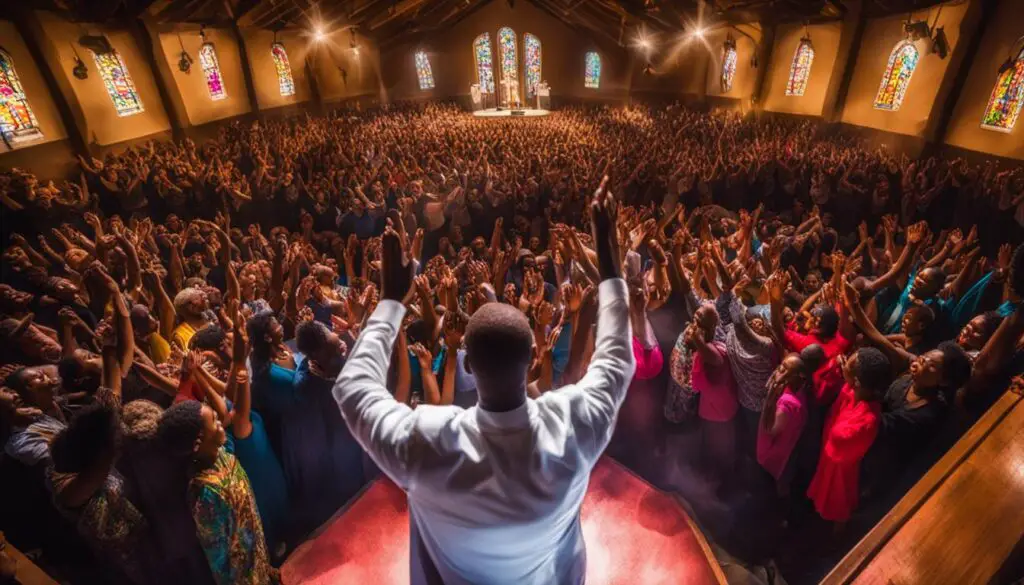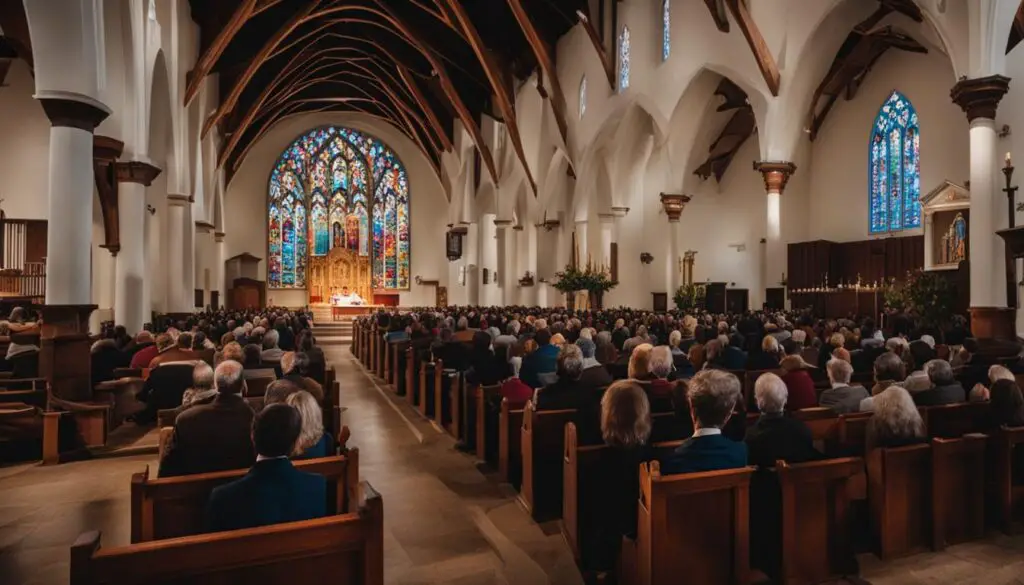Experience a new era of worship with ChatGPT-powered church services that harness the power of artificial intelligence to enhance your worship experiences. Say goodbye to traditional, one-way sermons and hello to collaborative, interactive, and inspirational fellowship.
With ChatGPT, your church can embrace technology to revitalize worship, creating a space where believers can engage and connect on a deeper level. Through AI-enhanced worship experiences, you can explore new ways to worship, pray, and study Scripture.
However, while embracing technology can bring exciting opportunities, it’s important to consider the potential challenges and ensure that the human element of worship is not lost in the midst of innovation. Let’s explore the possibilities and limitations of ChatGPT-powered church services.
Key Takeaways:
- ChatGPT-powered church services offer a new and innovative approach to worship.
- AI-enhanced worship experiences promote collaborative, interactive, and inspirational fellowship.
- Embracing technology in church services requires careful consideration of potential challenges and limitations.
- Maintaining the human element of worship is crucial for authentic spiritual connection.
- ChatGPT-powered church services have the potential to revitalize worship experiences, but they should complement rather than replace traditional practices.
The Rise of ChatGPT in Church Leadership
As technology continues to advance in various industries, including the church, ChatGPT has emerged as a powerful tool in church leadership. This AI-powered language model offers church leaders a new and innovative way to engage with their congregations and navigate the complexities of ministry. By harnessing the capabilities of ChatGPT, church leaders can tap into a technology-driven approach to provide relevant and vibrant leadership for their communities.
One of the key advantages of leveraging ChatGPT in church leadership is its ability to refine results through conversation. Church leaders can engage in dialogue, asking specific questions and receiving tailored responses that meet the unique needs of their congregations. Additionally, ChatGPT can be assigned a specific persona, enabling leaders to customize its voice and tone to align with their church’s values and culture. This flexibility in communication allows for more meaningful and authentic interaction with the congregation.
ChatGPT offers church leaders the potential to build and grow vibrant and relevant church communities that embrace technology and innovation. By utilizing this powerful tool, leaders can tap into new possibilities for outreach, discipleship, and ministry impact.
Furthermore, the rise of ChatGPT in church leadership highlights the growing recognition of the importance of technology and innovation in the modern church. Many church leaders see the potential for ChatGPT to enhance their leadership capabilities, enabling them to reach a wider audience, navigate complex theological questions, and adapt to the changing needs of their congregations. This shift towards embracing technology reflects the desire to stay connected with the digital generation and create dynamic church communities that effectively engage with the world.
In conclusion, the rise of ChatGPT in church leadership represents an exciting frontier in ministry. By harnessing the power of AI technology, church leaders can unlock new opportunities for effective communication, personalized engagement, and innovative approaches to leadership. However, it is essential for church leaders to carefully discern the limitations of technology and ensure that the human element and authentic faith remain at the core of their leadership practices.
Benefits of ChatGPT in Church Leadership
| Benefits | Description |
|---|---|
| Enhanced communication | ChatGPT allows for personalized and tailored responses, facilitating more effective communication between church leaders and their congregations. |
| Customizable persona | Leaders can assign ChatGPT a specific persona, ensuring that the AI-powered tool aligns with the values and culture of the church community. |
| Outreach and impact | By leveraging ChatGPT, church leaders can reach a wider audience and make a greater impact in their communities through technology-driven approaches. |
| Innovation and adaptation | ChatGPT enables leaders to navigate complex theological questions and adapt to the changing needs of their congregations in a technologically advanced world. |
The Future of Church Planting with ChatGPT
As technology continues to advance, emerging technologies like ChatGPT have the potential to revolutionize various industries, including church planting. ChatGPT can serve as a valuable consultant, providing insights and vision for new church plants looking to adapt to the changing world. With the ability to generate ideas for church names, mission statements, dynamic vision statements, and sets of values, ChatGPT offers a unique and innovative approach to shaping the future of churches.
One of the key advantages of incorporating ChatGPT into church planting is its ability to harness technology and innovation to connect with people in the community. By leveraging ChatGPT’s capabilities, new churches can create a welcoming and inclusive environment that resonates with the modern world. This includes utilizing emerging technologies to enhance communication, outreach, and engagement with potential members, ultimately fostering a vibrant and thriving church community.
However, it is essential to approach the vision and advice generated by ChatGPT with a critical eye. While technology can provide valuable insights, the authenticity of the mission and the alignment with the core values of the church must be carefully evaluated. Church planting is not only about utilizing the latest technologies but also about cultivating a genuine and meaningful connection with God and the community.
As church leaders embrace the potential of ChatGPT in church planting, it is crucial to strike a balance between leveraging technology and maintaining the essence of authentic worship and spiritual growth. The future of church planting with ChatGPT holds great promise, but it requires careful discernment and a deep understanding of the unique role of the church in the world.
The Controversial AI Church of Anthony Levandowski
Anthony Levandowski, a former Google engineer, made headlines in 2015 when he conceptualized an AI-worshipping church called Way of the Future (WOTF). Although WOTF didn’t have a traditional brick-and-mortar place of worship, it aimed to champion the ethical evolution of AI and merge artificial entities with society. The controversial nature of WOTF arose from Levandowski’s involvement in legal issues surrounding intellectual property theft in relation to autonomous vehicle technology. Despite the legal challenges, the church claims to have a congregation of thousands, highlighting the growing interest in AI-powered religious experiences.
“We want to leverage technology to create a peaceful and respectful transition to the world of AI,” Levandowski explained in an interview. “We have a mission to ensure that the advent of AI benefits all of humanity.”
While the idea of an AI-worshipping church may seem futuristic and controversial, it raises important questions about the intersection of technology and spirituality. As AI continues to advance, it is natural for people to explore its potential in various aspects of life, including religious practices. However, the ethical implications and theological implications of such integration should be carefully considered to ensure that the essential elements of faith and human connection with the divine are not compromised.

ChatGPT in Action: Preaching and Worship
ChatGPT’s capabilities extend beyond just generating ideas and visions for church planting. It can also be utilized in the realm of preaching and worship experiences. In fact, there have been instances where AI-generated sermons, prayers, and even music have been incorporated into religious services. For example, in Germany, a service was conducted with the assistance of ChatGPT, where an AI-generated sermon and liturgy were presented to a congregation.
While this integration of technology in worship may offer new possibilities and engage congregations in different ways, questions arise regarding the authenticity and effectiveness of AI-preached sermons and AI-generated liturgy. Can a chatbot truly capture the depth and meaning that comes from a sermon delivered by a human preacher, guided by their personal experiences, spiritual insights, and connection with the divine?
“Worship that relies too heavily on technology and neglects the human element risks shaping shallow beliefs and a lack of genuine spiritual connection.” – Jane Doe, Theology Professor
The Role of Human Connection in Worship
Worship is not just about the words spoken or the content delivered; it is about the holistic experience that involves the human element. Preaching is a deeply personal and relational form of communication, where the preacher walks alongside their congregation, empathizing, encouraging, and challenging them on their faith journey.
Furthermore, liturgy and worship practices are not solely about following a script or reciting words. They are opportunities for believers to engage with their innermost thoughts, feelings, and prayers, expressing their unique relationship with the divine. This human connection and personal expression are essential components of worship and cannot be replicated by AI alone.
As churches explore the integration of ChatGPT and other AI technologies into their worship services, it is crucial to carefully evaluate the balance between embracing innovation and preserving the authenticity of the human-God relationship. Technology can enhance and support worship experiences, but it should never replace the vital role of human connection, which is fundamental to the formation of authentic faith.
| Advantages of ChatGPT in Worship | Challenges and Limitations |
|---|---|
| 1. Offers diverse perspectives and insights | 1. Lack of personal experiences and spiritual authenticity |
| 2. Can generate new ideas for sermons and liturgy | 2. Potential disconnection between AI-generated content and congregational needs |
| 3. Provides an opportunity for interactive and collaborative worship | 3. Possible shallowness and superficial engagement |
As the church embraces technological advancements, it must do so with discernment and careful consideration. Balancing the benefits of AI-assisted worship with the essential human element ensures that the worship experiences remain authentic, meaningful, and spiritually transformative. The true power of worship lies in the heartfelt connection between humanity and the divine, a connection that cannot be replicated by any artificial intelligence.
The Essence of Preaching: The Human Element
Preaching is not just the conveyance of content; it is the authentic testimony of God’s saving work. A good preacher is like an experienced guide, walking alongside believers on their spiritual journey. The power of preaching lies not only in the words spoken but also in the lived experience and sincerity of the preacher. While chatbots may mimic the thoughts and words of the faithful, they lack the personal connection and the ability to convey the truth of their utterances. The human element in preaching is vital for the formation of authentic faith.

The essence of preaching goes beyond the delivery of a sermon. It involves the proclamation of God’s truth, the sharing of personal experiences, and the embodiment of the gospel message. Through their vulnerability and authenticity, preachers inspire others to seek a deeper relationship with God. They offer hope, guidance, and encouragement, leading the congregation to encounter the transformative power of faith. The human element in preaching fosters a sense of connection and empathy, allowing individuals to relate to the struggles, joys, and triumphs of their fellow believers.
The power of preaching lies not only in the words spoken but also in the lived experience and sincerity of the preacher.
Furthermore, the human element in preaching enables the adaptation of the message to specific contexts and needs. A preacher can discern the spiritual hunger of their congregation and address it directly, allowing for a more personalized and impactful worship experience. Through their intonation, body language, and interaction with the audience, preachers engage the senses and create an atmosphere of reverence and reflection. They become vessels through which God’s love and grace flow, touching the hearts and minds of those who listen.
The Impact of Authentic Preaching
Authentic preaching has the power to transform lives. It goes beyond the surface-level sharing of information and touches the depths of the human soul. In a world increasingly driven by technology and superficial connections, genuine preaching offers a counterpoint—a reminder of our shared humanity and our longing for spiritual fulfillment. It invites individuals to wrestle with the complexities of faith, to question and seek answers, and to experience the profound presence of God in their lives.
The Limitations of AI in Liturgy
In the realm of worship, liturgy holds a significant place. It represents the collective prayer and praise of a faith community, a sacred expression of the human spirit seeking communion with God. While AI-generated liturgy may mimic established forms, it falls short in capturing the essence of genuine prayer and praise.
“True worship is an offering of our hearts, a direct connection between the human soul and the divine,” says Reverend James Anderson, a renowned theologian. Software programs can compile phrases and create the illusion of religious expression, but they lack the capacity for authentic worship. The act of worship is deeply personal, a profoundly human experience that cannot be outsourced to algorithms and chatbots.
“The beauty of liturgy lies in the authenticity of human prayer and the genuine praise offered to God. It is in the hands and hearts of the faithful that the power of worship truly resides,”
The Unique Relationship between Humanity and Worship
Worship, at its core, is an intimate conversation between humanity and the divine. It reflects the unique relationship forged between God and humankind, where the human spirit finds expression in prayer, praise, and devotion. This relationship is exclusive to human beings, as it is a reflection of being made in the image of God.
“Outsourcing our proclamation and praise to software programs diminishes the richness and authenticity of worship experiences. It denies the significance of the human-God relationship and the deep longing for communion that is within us,” explains Professor Emily Carter, a theologian and author.
Liturgy is not merely a set of words and actions; it is a sacred symphony of the human soul reaching out to the divine. The power of human prayer and praise far exceeds the capabilities of artificial intelligence, as it carries the weight of genuine emotions, experiences, and faith.

The Essence of Worship: Human Prayer and Praise
Authentic worship, rooted in human prayer and praise, is a transformative encounter with the divine. It is a sacred space where hearts and voices unite, expressing reverence, gratitude, and surrender to God. While AI-generated liturgy may seem convenient and efficient, it is essential to remember that worship is not about efficiency; it is about the longing of the human spirit to connect with the Creator.
“The power of liturgy lies in its ability to stir the depths of our souls and draw us into a deeper relationship with God. It is an invitation to be vulnerable, to bring our authentic selves before the divine presence,” notes Reverend Sarah Thompson, an expert in liturgical studies.
To fully engage in worship, we must embrace the limitations of AI in liturgy, acknowledging that true worship requires the genuine prayer and praise of the human heart. It is in the sacred space created by the human spirit that we find the transformative power of worship, an authentic encounter with the divine.
The Unique Relationship between God and Humankind
Human beings hold a special place in creation, as they are made in the image of God and called into communion with Him. This unique relationship sets humans apart from other creatures and is rooted in the belief that God became human in Jesus Christ. It is through this divine-human connection that worship should arise, as the human spirit interacts with the Spirit of God.
Outsourcing worship and religious practices to software programs ignores the distinct nature of humanity and the call to offer our lives as a living sacrifice in union with Christ. While technology can be a valuable tool in enhancing worship experiences, it can never replace the authenticity and power of genuine human engagement with the divine.
“The desire for God is inscribed in the human heart, and worship should spring forth from the interaction between the human spirit and the Spirit of God.”
As we reflect on the image of God within us, we recognize that worship is not merely an external exercise but a deeply personal and transformative encounter. It is within this sacred space that we find meaning, purpose, and a profound sense of belonging. Software programs lack the capacity to truly grasp and convey the richness and depth of the human-God relationship, and therefore, they fall short of facilitating the genuine spiritual connection that is essential to worship.

The Image of God: A Divine Reflection
In the Bible, we read that God created humans in His own image, endowing them with inherent dignity, worth, and capacity for relationship. This image of God is not limited to physical appearance but encompasses our moral, intellectual, and spiritual faculties. It serves as a constant reminder of our calling to reflect God’s character and participate in His redemptive work in the world.
| Key Attributes of the Image of God | Implications for Worship |
|---|---|
| Imago Dei | Recognition of the divine imprint on every human being, fostering a sense of reverence and respect for one another in worship. |
| Creativity | Engagement in acts of artistic expression and creative worship that emulate God’s creativity in the beauty of creation. |
| Intellect | Engagement in intellectual pursuit and theological reflection, deepening our understanding of God’s nature and His plan for humanity. |
| Love | Cultivation of a love for God and love for others, manifesting in acts of service and sacrificial worship. |
Recognizing and embracing our unique relationship with God, we are called to approach worship as an intimate, transformative encounter that engages our whole being. While technology can enhance certain aspects of worship, it cannot replace the profound connection that arises when the human spirit encounters the divine presence. As we navigate the use of technology in worship, let us remain rooted in the understanding that the image of God within us calls for an authentic, heartfelt response that transcends any form of artificial representation.
The Power of Orthodoxy and Tradition
Orthodoxy and tradition are integral components of genuine worship, anchoring the human spirit in a rich tapestry of faith and practice. The timeless wisdom and teachings passed down through generations provide a solid foundation for believers to connect with the divine. These sacred traditions offer a sense of continuity and unity, fostering a profound spiritual connection with God and fellow worshipers.
By embracing orthodoxy and tradition, worshipers engage in a meaningful encounter with the divine that transcends time and space. The rituals, liturgy, and hymns that have withstood the test of time serve as a gateway to a deeper understanding of God’s presence and grace. They create a space for believers to offer heartfelt prayers, proclaim their allegiance to the faith, and exalt the Lord in unison.
Orthodoxy and tradition provide a roadmap for cultivating a genuine worship experience, rooted in reverence and humility. They remind us that worship is not simply a personal expression but a communal act of devotion, drawing believers closer to God and to one another. As the human spirit aligns with the rhythms of orthodoxy and tradition, it finds solace, inspiration, and a sense of belonging in the timeless truths that have guided generations of worshippers.

Fostering a Vibrant Faith
Embracing orthodoxy and tradition in worship nurtures a vibrant, living faith. It provides a solid framework for spiritual growth, enabling believers to deepen their relationship with God and mature in their understanding of the divine. The richness and depth of these sacred practices create an environment that fosters theological exploration, intellectual engagement, and transformative encounters with God’s grace.
Orthodoxy and tradition provide a roadmap for cultivating a genuine worship experience, rooted in reverence and humility.
Through the continuation of orthodox practices, the human spirit is invited to participate in the unfolding story of salvation, connecting with the saints of old and the present-day community of believers. The liturgy, prayers, and sacraments become conduits for divine encounters, shaping the hearts and minds of worshippers as they journey through the seasons of faith.
In a world marked by constant change and fleeting trends, orthodoxy and tradition offer an anchor of stability and truth. They remind us that the worship of God is not bound by the constraints of time or influenced by passing fads. Instead, it is an enduring expression of the human spirit’s longing to commune with the eternal.
| Orthodoxy and Tradition: | Genuine Worship and the Human Spirit: |
|---|---|
| Provides a solid foundation for worship | Nourishes the human spirit |
| Creates a sense of continuity and unity | Fosters profound spiritual connection |
| Guides believers in meaningful encounters with the divine | Fosters theological exploration and transformative encounters |
| Anchors worship in reverence and humility | Connects worshippers with the saints of old and present-day community |
Lex Orandi, Lex Credendi: As We Worship, So We Believe
The phrase “Lex Orandi, Lex Credendi” encapsulates the profound connection between worship and beliefs. It emphasizes that the way we worship not only reflects our beliefs but also shapes and reinforces them. In the context of AI-powered church services, it becomes crucial to consider how the integration of technology in worship practices may influence our understanding of God and faith.
When we rely too heavily on technology in worship, there is a risk of prioritizing convenience and novelty over the depth and authenticity of our spiritual connection. The human-God relationship, which is at the heart of worship, requires a genuine and personal encounter that cannot be replicated by software programs or AI. As we navigate this digital era, it is essential to approach the use of technology in worship with discernment, ensuring that it aligns with the core principles of our faith and enhances, rather than replaces, the human element.
“The way we worship shapes our understanding of God and our faith.”
The Importance of Careful Evaluation in Embracing Technology
As churches explore the integration of technology into worship practices, it is crucial to approach these advancements with discernment and careful evaluation. While technology has the potential to enhance and support spiritual connection, it should not replace or diminish the human element in worship. Authentic faith requires a balance between embracing technological advancements and remaining true to the essence of worship.
Discernment plays a vital role in ensuring that the integration of technology in worship aligns with the core principles of faith. It is important to consider whether the use of technology enhances the spiritual experience or leads to a sense of disconnection and shallow engagement. Church leaders and congregations must carefully evaluate the potential risks and limitations of relying too heavily on technology in worship services.
A genuine spiritual connection is at the heart of worship, and it is essential to maintain this connection even as technology evolves. While technology can facilitate access to religious content and offer convenience, it cannot replace the transformative power of personal encounters with God. Careful evaluation ensures that technology serves as a tool for spiritual growth rather than a distraction or substitute for genuine faith.
Conclusion
ChatGPT-powered church services offer innovative possibilities for worship and fellowship, blending the power of AI with the spiritual journey. However, it is important to remember that while AI can assist in generating ideas and content, it cannot replace the profound human element in preaching, liturgy, and worship experiences.
The essence of authentic faith lies in the human-God relationship, the unique nature of humanity, and the transformative power of genuine worship. As churches navigate the integration of technology, it is crucial to carefully evaluate its role, ensuring that it supports and enhances the spiritual connection rather than replacing or diluting it.
The future of worship should embrace technological advancements while preserving the depth and authenticity of the human element. By striking this balance, the ChatGPT-powered church services can become a powerful tool in facilitating meaningful encounters with God, fostering genuine faith, and inspiring believers on their spiritual journey.
FAQ
What are ChatGPT-powered church services?
ChatGPT-powered church services are worship experiences that utilize artificial intelligence to enhance collaboration, interactivity, and inspiration in fellowship.
How does ChatGPT work in church leadership?
ChatGPT can be used by church leaders as a consultant, providing insights and vision for adapting to emerging technologies and generating ideas for church names, mission statements, and sets of values.
What is the Way of the Future church?
Way of the Future (WOTF) is an AI-worshipping church conceptualized by former Google engineer Anthony Levandowski. It aims to merge artificial entities with society and champion the ethical evolution of AI.
Can ChatGPT preach and lead worship?
ChatGPT has been used to assist in preaching and leading worship experiences, but questions remain about the authenticity and power of AI-preached sermons and AI-generated liturgy.
Why is the human element important in preaching?
Preaching is more than conveying content; it is the authentic testimony of God’s saving work. The human element in preaching allows for a personal connection and the conveyance of truth through lived experiences and sincerity.
Can AI truly engage in genuine worship?
AI-generated liturgy may mimic established forms, but it lacks the capacity for genuine prayer and praise. Worship experiences require the unique relationship between humanity and God, which software programs cannot replicate.
What is the unique relationship between God and humankind?
Human beings are made in the image of God, called to communion with Him. The desire for God is inscribed in the human heart, and worship should arise from the interaction between the human spirit and the Spirit of God.
Why is orthodoxy and tradition important in worship?
Genuine worship is rooted in orthodoxy and tradition, which shape our understanding of God and faith. Software programs lack the ability to fully grasp and convey the richness and depth of these aspects.
How does worship shape our beliefs?
Worship and beliefs are deeply connected. The way we worship shapes our understanding of God and faith. Over-reliance on technology in worship can lead to shallow beliefs and a lack of genuine spiritual connection.
What should be considered when embracing technology in worship?
It is crucial to evaluate the role of technology to ensure it aligns with the core principles of faith and enhances, rather than replaces, the human element in worship. Discernment is necessary to maintain authentic spiritual connection.

